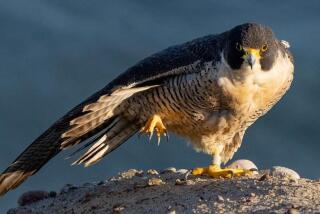Statewide Captive Breeding Program Started : Bald Eagle Population Slowly Soaring
SAN FRANCISCO — Isolated far away from the daily crowds at the San Francisco Zoo, two young bald eagles huddled on a Monterey Cypress and glared at the visitor peeking through an observation slit. Their head feathers raised like the hackles of a angry dog.
“They are very skittish around humans,” whispered George Carpenter, a zoo biologist who studies the breeding behavior of bald eagles, “which is good. You have to be very careful. If this was the breeding season we wouldn’t even be talking out here.”
The San Francisco Zoological Society, as part of a statewide effort to reintroduce bald eagles throughout their former California range and to increase the endangered species’ population, is starting the first captive breeding program for the majestic predators in the Western United States.
By 1991, the society’s plans call for a new $2-million aviary complex on zoo grounds where six breeding pairs of bald eagles will be producing 24 eaglets a year for release into the wild.
Struggling to Survive
The Founding Fathers chose the bald eagle as the nation’s symbol in 1782, but the beleaguered bird has been struggling for survival for decades. The U.S. Fish and Wildlife Service rates the bird as “threatened” in five states, and “endangered”--close to extinction--in California and every other state except Alaska, where 7,500 pairs flourish. Hawaii never had any.
By the late 1960s, the bald eagle population in California, once in the thousands, had plummeted to 20 nesting pairs. And a breeding range that once extended from the Oregon border to the beaches of Baja California, had shrunk to a pocket of remote mountainous counties in the state’s far north.
But during the past 15 years, thanks largely to determined conservation efforts and the 1972 banning of DDT, the bird has been making a comeback, biologists say. The latest surveys count about 65 pairs in the state. “We are gradually seeing a rebound,” said Mark Jenkins, wildlife biologist for Pacific Gas & Electric.
Jenkins chairs the bald eagle working team, a group formed in 1974 to coordinate public and private bald eagle conservation programs in California. The group’s goal is to rebuild the state population to 140 nesting pairs, the target set by the Fish and Wildlife Service as the first step toward removing California’s bald eagles from the endangered list.
Captive Breeding
“We’re battling on two fronts,” Jenkins said. “We still need to protect and manage habitats. But if we ever hope to achieve our recovery goals, captive breeding is really a significant part of the program.”
Carpenter and the rest of the San Francisco zoo’s avian conservation team went through a trial run of sorts for their project last summer. Three eggs snatched last March from wild nests in Shasta County were hatched by the Predatory Bird Research Group in Santa Cruz and then put into the zoo.
Placed in a pen next to a pair of adult birds, the awkward chicks were hand fed with a bald eagle puppet, to minimize human contact. To muffle any human sounds, tapes of ocean waves, flowing streams and babbling brooks played in the background.
Carpenter explained that it is critical that the fledglings have adult eagles nearby and not “imprint” on humans. “We try to mimic the wild as much as possible so they are physically and psychologically healthy bald eagles,” he said. “That way when they look at each other they say ‘Ah, hah! I’m an eagle!’ Otherwise they think they’re humans and and try to hang out around people.”
Since eagles lay only one clutch of two or three eggs a year, zoo biologists will have to turn to a trick called “double clutching” if their six mating pairs are to produce 24 young a year. In this method the original clutch is taken away after five days; three weeks later the surprised mother lays eggs again, which she would not do if her first brood remained in the nest.
Hacking Towers
At 11 weeks the chicks will be transferred from the breeding center to what are called hacking towers, a kind of rugged halfway house to introduce the fledglings to the wild. Because bald eagles tend to return to where they nested to breed, biologists locate the towers--caged platforms on top of 40-foot tall utility poles--where they want the birds to settle permanently.
In transferring the birds to nature, wildlife experts erect hacking poles in the wild to assist in the transition. For example, one of the project’s eaglets was released this summer into the Ventana Wilderness Sanctuary along the Big Sur coastline of Central California. “You have to continue providing food to them for a couple of months after their release until they get the hang of hunting on their own,” said Glenn Stewart, director of the sanctuary. Stewart would lift food to the birds in a dumb waiter that extended the length of the hacking pole.
David Garcelon, president of the Institute for Wildlife Studies on Santa Catalina Island, the only other bald eagle release site in California, has placed 33 eaglets in the channel islands since 1980. Garcelon has had to rely on a scarce supply of eaglets imported from Canada and Washington.
“One of our biggest problems in releasing eagles is that there haven’t been a lot of birds available,” he said. “Captive breeding offers a much needed option.”
More to Read
Sign up for Essential California
The most important California stories and recommendations in your inbox every morning.
You may occasionally receive promotional content from the Los Angeles Times.









